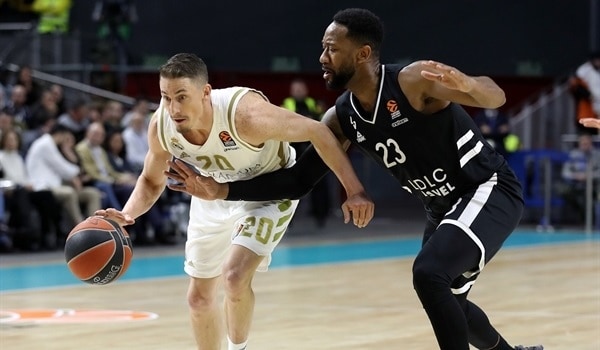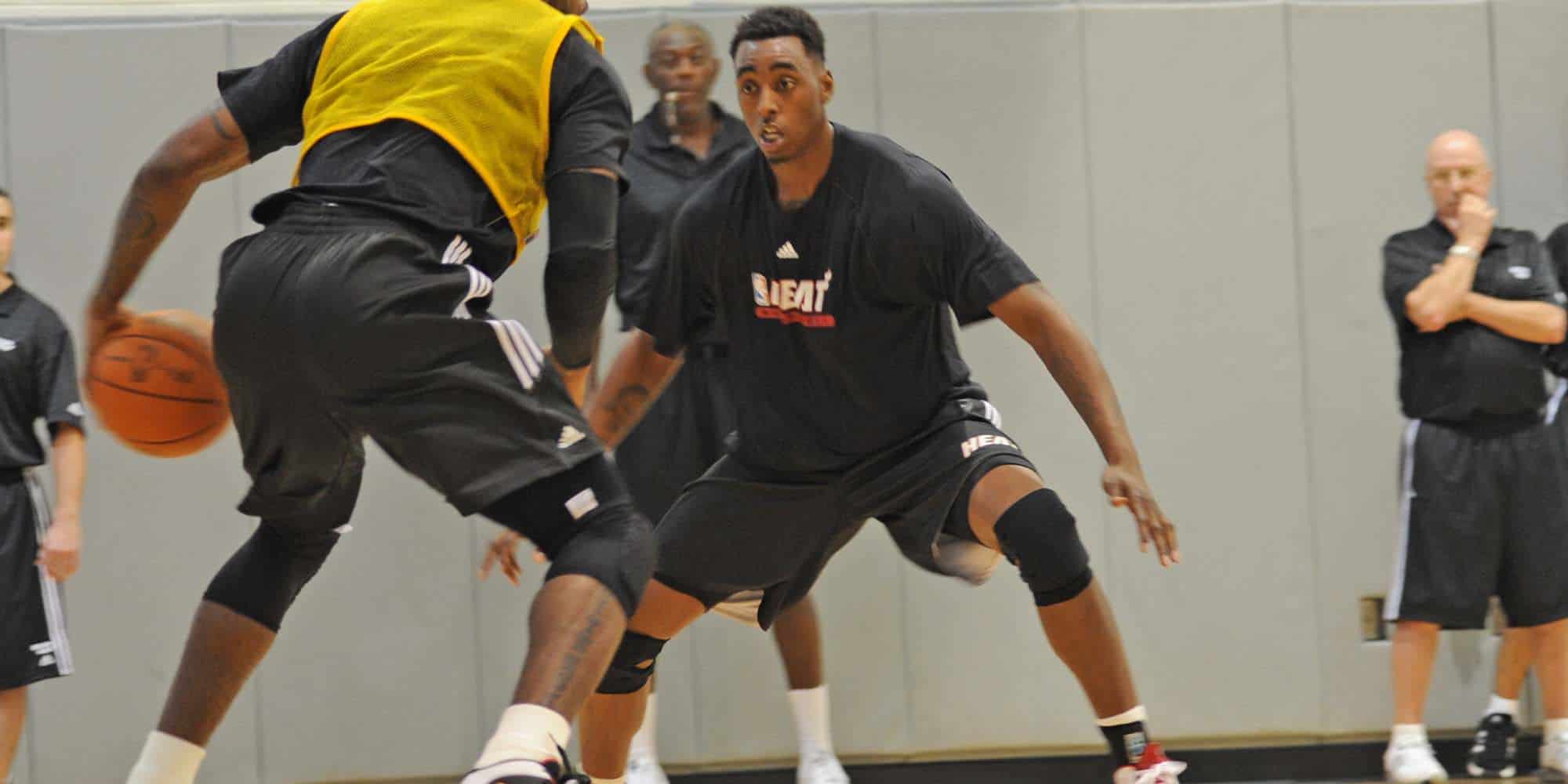You’ve probably witnessed at least one discussion about how basketball used to be tougher ‘back in the day’. The fact hand-checking was allowed often forms part of their argument.
Full disclosure, I love the exciting nature of the modern game but I do believe it is a bit too soft in some aspects. However, I’m not looking to beat the old VS new drum here. Instead, this text is going to explore the much-discussed hand-checking rule and how it forever changed the NBA game.
Some fact-based comparisons of the old game and the new game will inevitably come up and whether the changes brought by the elimination of hand-checking are for better or worse is purely up to you. With that out of the way, let’s clearly define hand-checking.

What is hand-checking?
Even if you’ve never heard of hand-checking before, you’ve probably done it or experienced it during pickup games.
In the simplest possible terms, hand-checking is when a defender uses one or both hands to initiate contact by placing it on the offensive player to better control, i.e. “check” them and impede their progress.
The arm doesn’t have to be fully extended, even a partially extended arm placed on an offensive player can make it much more difficult to drive/score and much easier for the defender to stay in front.
Looking at the game today, it can be difficult to fathom that such a method of playing defense was ever allowed.
Once Upon A Time…
You are probably familiar with how the NBA was dominated by great centers back in the day and you practically had to have a dominant center to contend for a championship. The game was almost painfully slow and perimeter play was nowhere nearly as developed as it is today.
It’s true that hand-checking was a major contributing factor to this but it was far from the only one. Coaches and executives simply looked at the game differently and analytics that act as the driving force behind many decisions and adjustments in the modern NBA were all but unknown back then.
With the game centered around big men and hand-checking allowed, the game was much more physical which led to many situations that would be a clear foul today not being called back then. Now, this probably didn’t bother spot-up shooters that much since their game was never centered around driving.
On the other hand, it is easy to see why this would discourage players who wanted to drive to the rim from doing so. Even if you could get past your primary defender, and that’s a big “if”, there’s a massive center waiting under the rim since stretch fives were non-existent.
You will get hit, hard, and free throws would not be guaranteed. If you want a great example, just watch any defensive compilation of the Bad Boy Pistons on YouTube since they pushed these rules to their absolute limits.
Seeds of change
Even if powerful centers dominated the show in the 80s and early 90s, that doesn’t mean that perimeter stars did not exist. Larry Bird, Magic Johnson, John Stockton, Reggie Miller, and Julius Erving are just a few of the most prominent ones. Now, I know what you’re thinking, one name is missing from this list.
That name is almost single-handedly responsible for the beginning of the end of hand-checking. When Jordan’s Bulls started dominating the NBA, basketball fans were introduced to a brand new form of basketball.
A team centered around a revolutionary system and two perimeter stars in Jordan and Pippen. The Bulls ruled the league and perimeter play was gaining popularity because everyone wanted to be like Mike. He was the face of the NBA and he was extremely marketable.
Jordan’s style of play was both novel and attractive to fans who simply couldn’t identify with 7’ big men. The NBA was more popular than ever and young players everywhere wanted to hone their perimeter skills. NBA leadership saw the potential.
When MJ retired for the first time, the league “modified” the rules so that hand-checking was not allowed in an attempt to encourage more perimeter play without the league’s premier perimeter star. They may have also been worried (read: were totally worried) that their rating would sharply decline without MJ.
Predictably, the ratings dropped like a rock. However, there was very little implementation of the new rules (hence the quotation marks), and they were completely thrown out of the window once MJ (and the ratings) came back.
The end of an era
Jordan’s second three-peat not only cemented his legacy, but an entire generation of up and coming players was raised honing their perimeter game and it became clear that a dominant center was no longer the only recipe for a championship.
The hand-checking rule survived for a few more years after MJ’s second retirement in 1998 but it was clear that the perimeter game was the way of the future and the NBA wanted to unleash its full potential.
When hand-checking was finally banned following the 2003/04 season, the NBA game would be forever changed. The last representatives of the old guard of centers were on their way out and the league was primed for a takeover by a new crop of dominant perimeter players.
Guys such as LeBron James, Kobe Bryant, Dwayne Wade, and Carmelo Anthony were the new faces of the league and defenses had to find a new way to stop them. This would turn out to be a very difficult task and players like these would thrill the fans on a nightly basis.
Even it if did take a few more seasons for the speed of the game (measured by pace – the average number of possessions per game) to go up, this new brand of basketball was much more attractive and exciting to watch and there was a lot more scoring going on.
Could hand-checking ever make a comeback?
The wide-spread implementation of analytics in basketball was the final evolutionary step towards the full adoption of the perimeter game which became so prevalent that the center position was starting to become nearly useless beyond rim protection.
Had that trend continued, a case (albeit a weak one) could have been made for bringing hand-checking back in some form. Fortunately, the big men of the NBA also evolved to become far more complete players than any of their predecessors.
These developments have brought us to what is arguably the fastest and most exciting era of NBA basketball in history. Hand-checking is now rightfully seen as a relic of the past and even the most bitter nostalgic will probably have to admit that the past is exactly where the hand-checking rule belongs.


“Even the most nostalgic will have to admit hand checking belongs in the past” are you joking? Yeah I’m sure the nostalgic people love the fact that any contact is considered a foul today. And the number of stoppages and ref involvement is off the charts.
80s had way more fouls.
FACTS! and the 80s had higher scoring than the 2000s and 2010s and thats without heavy use of the 3-ball
If anyone today could PLAY THE POST, Hand Checking would be back.
Personally, I DESPISE most of today’s game – too much Grinnell System and Nellie Ball to it, NO DEFENSE worthy of the name, it’s all down to which team has the hotter hands and THAT IS BLOODY BORING.
I disagree with the start of changes to the hand check rule. It started when a 6’9 inch guard named Magic Johnson. Refs totally swallowed the rule because they had to. Magic would have fouled out if they did not stop calling the hand check rule. Bird stayed at small forward. The eastern conference still called it. If Magic would have played small forward then the hand check rule could have continued to be enforced. When the rule was applied to Magic one way and Nate McMillian another that’s when I noticed the western conference swallowed the hand check rule in Magic Johnson’s favor. Nate would foul out trying to guard Michael Adams of Denver but when Denver played LA Magic could impede his momentum. Then Hardaway and Stockton would get the hand check calls all the time. It was frustrating to watch.
LOL. Yep. Imagine Wilt or Jabbar without hand checking. They would begging for the hand check rule to keep them from scoring 50 a night.
Why did the Lakers scored 117 points per game then in 1986 and NO TEAM averaging less than 99 points? Why did the 2007 Eastern conference only have 5 teams average over 100? Why did Adrian Dantley shoot 56 PPG as a SF? they talk about hand checking being tougher, but these guys move their feet and use their entire bodies to guard now.
That’s why Jordan is the GOAT. In today’s game, Jordan would have averaged 50 PPG, easily. They would then have to reestablish the rule again with a young and prime MJ.